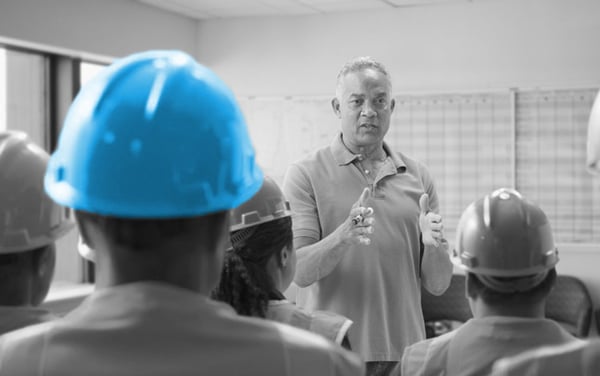This is not just the path toward improved safety and lower safety-related costs; it is also the path to walk if your goal is greater customer retention, higher sales, and maximizing profits.
The trend toward “total engagement” has been emerging for the past five to 10 years: a trend driven at times by the ongoing need to attract and retain talented people and by the need to address a myriad of other business objectives. Employee engagement is the key to success for virtually all corporate initiatives; from wellness to safety programs, from sales to profitability, practically all successful attempts to improve performance start by improving employee engagement. It would therefore seem logical that employee engagement initiatives would emanate from the very top of an organization with directives handed down from executives to HR and operations managers.
In my experience, what actually happens is that some forward-thinking department manager deploys employee engagement tactics that produce impressive results catching the attention of those in the C-Suite. Very often, that manager is in charge of safety.
While I’m starting to find more companies that seem to understand that virtually all their strengths, weaknesses, opportunities, and threats can and should be looked at through the lens of employee engagement, I’m still not finding many that act accordingly at a high level. If they identify training as a weakness, they often spend most of their time discussing whether there is better training so ware that they should deploy. If they see an opportunity to lower safety costs related to incidents such as “struck-bys” or “slips and falls,” they discuss purchasing better hard hats and work boots. While these conversations are taking place, what they really need is someone in the room to stand up and say, “Let’s look at our employee engagement levels first.”
Employee Engagement Foundational to Improving Safety
The reason this does not happen as often as it should is that it requires a more thoughtful ap- proach and will take longer than simply deciding to purchase a new training program or more PPE. And the reason that ideas like this do not flow as easily as they should within an organization is that large companies still have siloed departments that oftentimes prevent them from getting organization-wide efforts going.
In reality, what usually happens is that one department (generally the one with the greatest pain point) creates a program and, if that program succeeds at a significant enough level, it catches the attention of other departments and/or the executives. From there it may or may not expand, depending on how forward thinking the company is and any number of other factors. Regardless of where it ends, the department that is most likely to get the ball rolling with an employee engagement program that changes employee behaviors is safety.
This makes sense if you think about it, especially in larger organizations that have a great deal riding on how safely they work. Safety-related spending (a company’s loss-pick) trends upward at 5-10 percent annually for many companies even if they perform at a relatively stable level. Costs related to insurance, claims, health care, regulation, and the like are the driving force behind this general tendency toward increasing safety-related costs. Those types of annual spending increases are going to naturally lead to discussions about how to “solve the problem.”
Safety managers noticed long ago that they can’t really improve safety unless they can break through the clutter of everyday life and truly engage with employees. When they have exhausted most other tactics, companies come to realize that to improve safety, they need to create employee engagement/recognition/rewards programs that amplify and enable their safety message to get through. They also know that properly built programs do not o er cash as the award, because cash gets confused with compensation, but instead o er a wide variety of tangible merchandise and travel awards to truly capture and hold the attention of workers.
Share and Protect Your Success
But what comes next? Now, you, as a safety manager, have successfully overseen the creation of a great program that is addressing your needs by using engagement tactics and targeting the behaviors that help prevent accidents. The program is working, other executives and managers in the company have noticed, and they come calling because they want a piece of what you have . . . an engaged workforce.
The overtures may come from other department heads interested in improving training, lowering turnover, creating a wellness program, increasing customer retention, or any number of other initiatives. They will all want to know how you are moving your needle, how their department may benefit from your experience, and how they can latch on to the success of your program. The attention may also come from senior executives and “bean counters” who see the positive scale impact of what you are doing and who direct other department heads to mirror your efforts and results.
So how should you react to others who want to share in your success? My first word of advice is, of course, “graciously,” in that you all play for the same team and shared company success is a rising tide that will truly lift all boats. You should look, however, for mutually beneficial ways to connect your initiatives with others while being very careful not to dilute your “safety brand.” Make no mistake about it, by the time you have successfully improved safety by deploying employee engagement tactics, you will have created a “brand” that now has value and that should be shared only in mutually bene cial ways. It will be easiest to accomplish this if you start by connecting with other initiatives that compliment your objectives and goals.
This is the first step in expanding from a one-dimensional program into a “Total Rewards” offering.
Infuse New Energy with Wellness
For safety, there can be no better example of a program that has complimentary objectives than wellness. Safety and wellness are flip sides of the same coin with many objectives that directly overlap. In fact, the next step for many of my customers with long-term successful safety programs that are looking for innovative ways to infuse energy into the program is to add a wellness component (even if HR didn’t come and ask for it). A few simple examples of how safety directly connects to wellness:
■ Smokers tend to miss more days of work because they are sick more often, putting pressure on others to cover their shifts (drive their vehicle, run their routes), and the people covering their shifts are more likely to have an accident because they lack familiarity with the position.
■ Overweight and obese drivers and heavy equipment operators are more likely to have sleep apnea and less likely to get a good night’s sleep, causing them to work while tired and leading inexorably to more accidents.
■ Workers with high blood pressure or hypertension who are not aware of their afflictions and who do not properly mitigate their medical conditions are more susceptible to mood swings that can invite dangerous situations into the workplace.
For a safety department, there can be a real potential benefit to partnering up with HR or some other department to extend the bene ts of the safety recognition/rewards program it has created to also address and improve wellness. The trick is to do so without distracting or damaging the success enjoyed on the safety side. In other words, to make the additional wellness component synergistic while maintaining the core messaging that made the safety program successful to begin with.
It is easy to see how wellness can be joined to safety to the bene t of both initiatives, and of course the opposite would also be true. If your company has a successful wellness program and safety is lagging behind, see whether you can link safety to wellness to begin working your way toward a total recognition/total rewards program. To do so is to ensure that your company has elevated levels of employee engagement, a measuring stick that is now widely recognized as the most important for overall business success.
Time and time again, Gallup’s State of the American Workplace Study has shown that 70 percent of U.S. workers are not engaged at work and that the most successful companies are the ones that have the highest levels of employee engagement. Highly engaged companies benefit from having positive working relationships between employees and managers and employees and co-workers. This is not just the path toward improved safety and lower safety-related costs; it is also the path to walk if your goal is greater customer retention, higher sales, and maximizing profits. Nothing will catch an executive’s attention quicker than a promise of incremental pro table growth, and that is exactly the promise of today’s properly designed recognition/reward (engagement) programs.
To progress down the path from a single, to a bilateral, to a multilateral program will eventually take buy-in from managers in different silos and executives in the most key positions. It cannot (pragmatically speaking) take place overnight, so it intrinsically needs to take hold in one place and then spread throughout an organization. Safety departments tend to be the best environment for these “green shoots” to emerge, leading the way toward a true “Total Engagement Program” that drives overall organizational improvement.
See how Republic Services has improved their driver safety:




